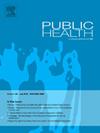Understanding pregnant women's health literacy strengths and challenges: a cluster-based exploration in the Health Literacy in Pregnancy (HeLP) study
IF 3.2
3区 医学
Q1 PUBLIC, ENVIRONMENTAL & OCCUPATIONAL HEALTH
引用次数: 0
Abstract
Objectives
Across populations there is frequently wide variation in the strengths and challenges that people experience regarding their health literacy and their digital health literacy. Given these variations, it is important that tailored care strategies are developed. However, there is limited research about the diversity of health literacy strengths and challenges among pregnant women. Thus, the aim of this observational study was to explore the diversity among pregnant women in Denmark.
Study design
This is an observational study, nested in the HeLP cohort and Health Literacy in Pregnancy (HeLP) study.
Methods
Hierarchical cluster analysis was used to explore patterns of strengths and challenges among 681 pregnant Danish women. Health literacy was measured using the 44-item Health Literacy Questionnaire (HLQ). Digital health literacy was measured using the eHealth Literacy Questionnaire (eHLQ).
Results
Overall, women had average scores above 2.90 for HLQ scales 1 to 5, average scores above 3.70 for HLQ scales 6 to 9, and average scores above 2.80 for the eHLQ. However, cluster analysis-based examination revealed 6 groups of women with large variations in their patterns of health literacy and digital health literacy strengths and challenges. Cluster 1 scored 3.96 on HLQ scale 6: Ability to actively engage with healthcare providers, while cluster 6 scored 2.34 on the same scale. Furthermore, there was considerable diversity in participant characteristics across the groups.
Conclusion
This study highlights that although relatively high health literacy and digital health literacy scores suggest a generally skilled population, averages do not fully capture the disparities present among groups. Study findings offer important insights for designing tailored strategies to improve maternal health outcomes in future studies.
了解孕妇健康素养优势与挑战:基于集群的孕期健康素养(HeLP)研究探索
在不同人群中,人们在健康素养和数字健康素养方面所面临的优势和挑战往往存在很大差异。鉴于这些变化,制定量身定制的护理策略非常重要。然而,关于孕妇健康素养优势和挑战的多样性的研究有限。因此,本观察性研究的目的是探讨丹麦孕妇的多样性。这是一项观察性研究,嵌套在HeLP队列和孕期健康素养(HeLP)研究中。方法采用层次聚类分析对681名丹麦孕妇的优势和挑战进行分析。采用44项健康素养问卷(HLQ)测量健康素养。使用电子健康素养问卷(eHLQ)测量数字健康素养。结果总体而言,女性HLQ 1 ~ 5项平均得分在2.90以上,HLQ 6 ~ 9项平均得分在3.70以上,eHLQ平均得分在2.80以上。然而,基于聚类分析的检查显示,6组妇女在健康素养模式和数字健康素养优势和挑战方面存在很大差异。集群1在HLQ量表6上得分为3.96:积极参与医疗保健提供者的能力,而集群6在同一量表上得分为2.34。此外,各组参与者的特征也存在相当大的差异。本研究强调,尽管相对较高的健康素养和数字健康素养得分表明总体上有技能的人口,但平均值并不能完全反映群体之间存在的差异。研究结果为在未来的研究中设计量身定制的策略以改善孕产妇健康结果提供了重要见解。
本文章由计算机程序翻译,如有差异,请以英文原文为准。
求助全文
约1分钟内获得全文
求助全文
来源期刊

Public Health
医学-公共卫生、环境卫生与职业卫生
CiteScore
7.60
自引率
0.00%
发文量
280
审稿时长
37 days
期刊介绍:
Public Health is an international, multidisciplinary peer-reviewed journal. It publishes original papers, reviews and short reports on all aspects of the science, philosophy, and practice of public health.
 求助内容:
求助内容: 应助结果提醒方式:
应助结果提醒方式:


